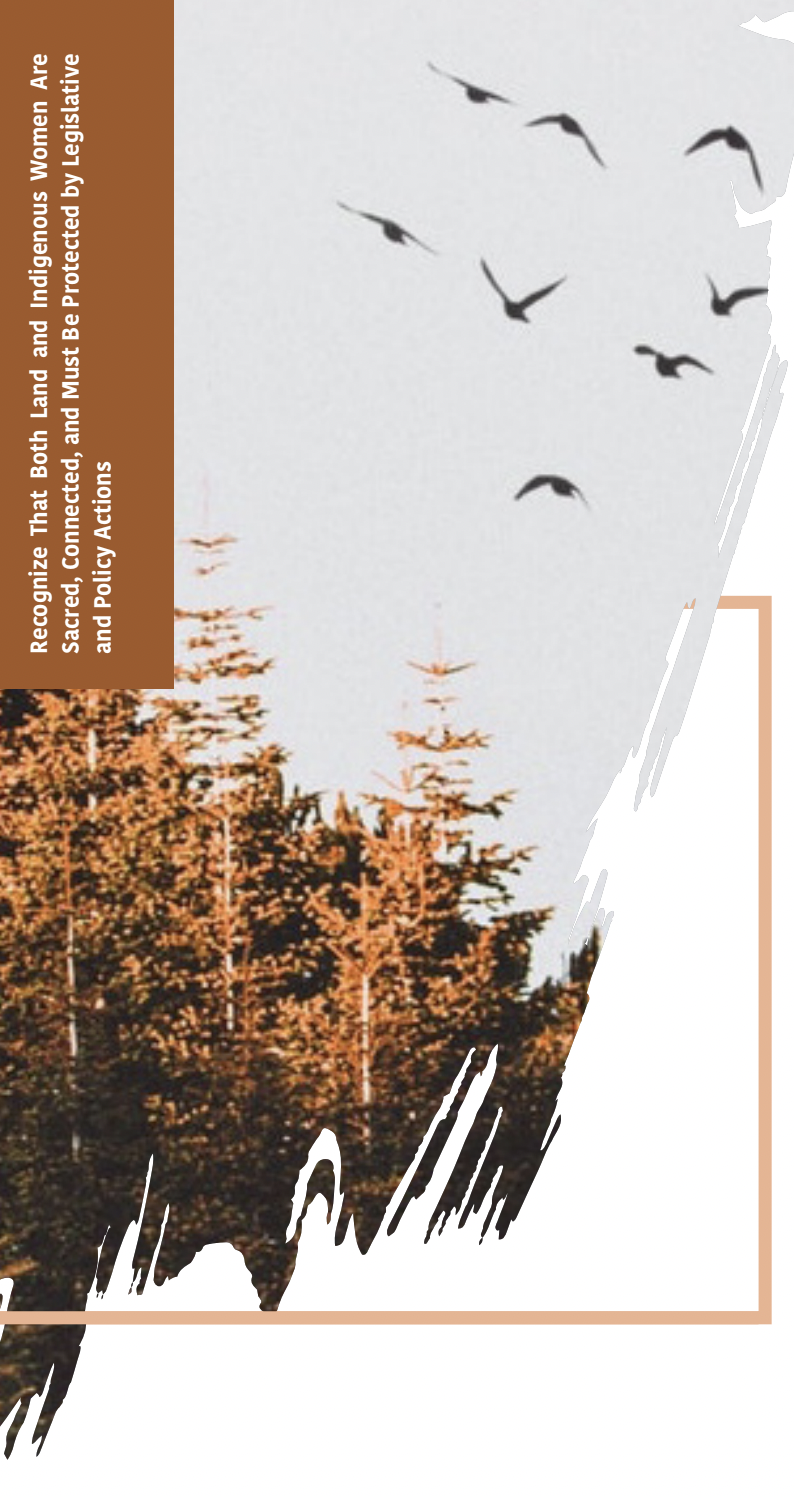Indigenous Women and Indigenous Land
 Point 6: Protecting the Sacred
Point 6: Protecting the Sacred
The National Indigenous Women’s Resource Center, Indian Law Resource Center, National Congress of American Indians, Pouhana O Nā Wāhine, Alaska Native Women’s Resource Center, StrongHearts Native Helpline, and the Alliance of Tribal Coalitions to End Violence collaborated on a 6-Point Action Plan for Restoring Safety of Indigenous Women. Point 6 of the Action Plan calls for advocacy to “recognize that both land and Indigenous women are sacred and connected and must be protected by both legislative and policy actions.”
“This insight was developed from our organizations’ shared understanding that while traditional, Indigenous governments took varied forms before colonization began, Indigenous women were protected and often held as sacred within their nations,” says Chris Foley, Attorney, Indian Law Resource Center. “However, as the impacts of the European invasion, colonization, and land theft devastated our peoples, Indigenous women and Indigenous lands in America have been left vulnerable to violence and exploitation.”
American Indian, Alaska Native, and Native Hawaiian women and girls suffer extreme and disparate levels of gender-based violence. For those living in rural and remote communities on Tribal lands and in Alaska Native villages, this problem is especially severe. In these communities, Tribal and Village governments are often the only government presence, yet their criminal jurisdiction to protect their women and children from violence is limited or even barred by discriminatory federal law. Meanwhile, state and federal governments that could do so fail to prevent, prosecute, or punish these crimes. Indigenous women are denied the right to access justice, and their human rights are violated.
Violence against Indigenous women, including the crisis of missing and murdered Indigenous women (MMIW) as its most extreme manifestation, is largely the result of the introduction of non-Indigenous ideas of misogyny and racial discrimination and the establishment of laws and policies that advance the theft of Indigenous lands and resources, including by undermining our Indigenous governments. Among the most egregious examples is the United States Supreme Court’s 1978 decision in Oliphant v. Suquamish decision holding that Tribes had no authority to exercise criminal jurisdiction over non-Indian offenders who committed crimes on their lands. Having prevented Tribes from protecting their citizens, the federal and, in some places, state governments were left to administer criminal justice on reservations and in Alaska Native villages. They have done almost nothing.
Recent 2022 legislative findings in VAWA 2022 show that there has been little improvement in restoring safety to Indigenous women since VAWA 2013. The murder rate for Indigenous women is ten times the national average on some reservations, and a 2017 report by the U.S. Department of Justice cited in the VAWA 2022 Findings states that in 66% of the criminal cases in Indian country that federal prosecutors declined to prosecute, the cases involved assault, sexual assault, or murder.
The epidemic of violence against Indigenous women highlights the United States’ failures not only under its law, including its trust responsibility to Indian nations to help Tribes safeguard their Indian women but also under international human rights law. “Since 2007, the Center has been collaborating with Tribes and Native women’s organizations on a strategy that views violence against Indigenous women through a human rights lens, not simply as a domestic or law enforcement issue,” says Jana Walker, Attorney, Indian Law Resource Center. “International advocacy complements grassroots efforts by adding top-down world pressure on the United States to meet its obligations to end violence and discrimination against Indigenous women.”
The United Nations (UN) and American Declarations on the Rights of Indigenous Peoples are the most important international human rights instruments for Indigenous peoples’ rights. Over several decades, both were negotiated by Indigenous nations and peoples, advocates, and the national governments under which we now live. The UN and American Declarations have been adopted by the United Nations and the Organization of American States respectively, and now stand as consensus statements of the principles to which the United States has committed itself when dealing with Indigenous peoples as collectives and Indigenous women as individuals.
The two Declarations contain important provisions regarding Indigenous peoples’ rights of self-determination, right to self-government, land rights, and Indigenous women’s rights to live free of discrimination and violence. In the UN Declaration, for example, Article 4 states that “Indigenous peoples, in exercising their right to self-determination, have the right to autonomy or self-government in matters relating to their internal and local affairs, as well as ways and means for financing their autonomous functions.” Regarding land rights, Article 25 states that “Indigenous peoples have the right to maintain and strengthen their distinctive spiritual relationship with their traditionally owned or otherwise occupied and used lands, territories, waters and coastal seas and other resources and to uphold their responsibilities to future generations in this regard.” Article 26(2) states that “Indigenous peoples have the right to own, use, develop and control the lands, territories, and resources that they possess by reason of traditional ownership or other traditional occupation or use, as well as those which they have otherwise acquired.” And in Article 22(2), the UN Declaration states that “States shall take measures, in conjunction with Indigenous peoples, to ensure that indigenous women and children enjoy the full protection and guarantees against all forms of violence and discrimination.”
Read together, these principles of land rights and self-government guide the law reform work needed in the United States to secure safety for Native women and to protect our lands and resources.
While the UN and American Declarations acknowledge Indigenous peoples’ rights and the United States has endorsed these principles, United States law falls short of these minimum international standards. Much more must be done to end violence and discrimination against Indigenous women and to protect Indigenous lands and resources from unwelcome exploitation and environmental degradation. These goals are woven together so tightly that it is nearly impossible to pursue one alone. We must do both, and we must do both now.




